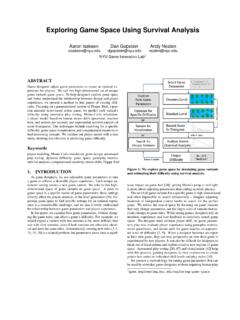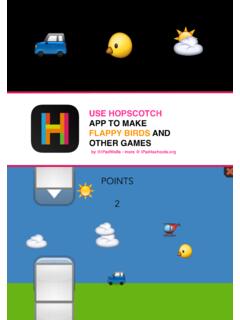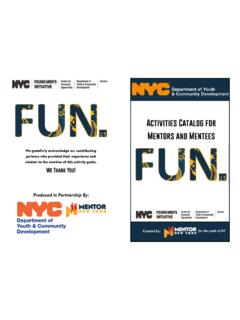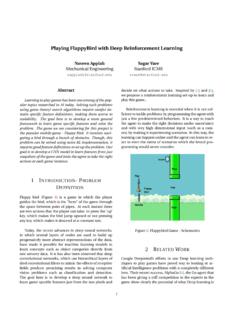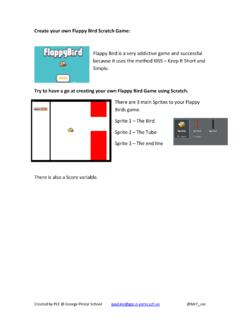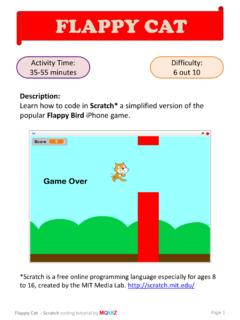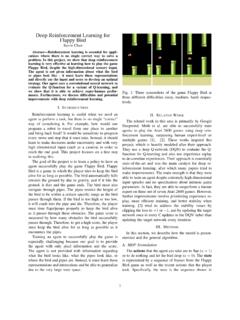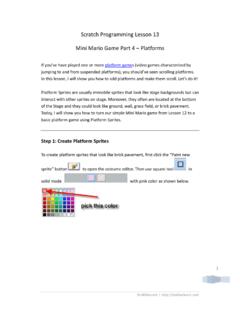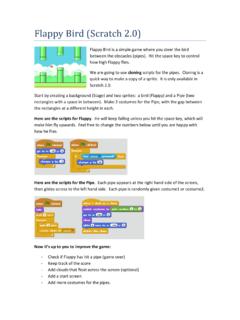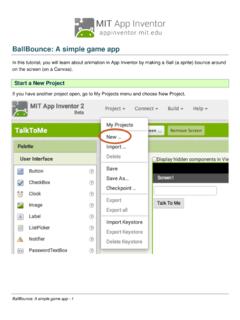Transcription of PROJECT “FLAPPY CRAB”: AN EDU-GAME FOR MUSIC …
1 PROJECT flappy crab : AN EDU-GAME FOR MUSIC LEARNING Cristina Maria Cardoso Gomes, , Mauro Jorge Guerreiro Figueiredo, Ph. D.*, Jos Bidarra, Ph. D. and Jos Duarte Cardoso Gomes, Centro de Investiga o em Artes e Comunica o, Universidade Aberta, Universidade do Algarve, Portugal *Centro de Investiga o Marinha e Ambiental, Centro de Investiga o em Artes e Comunica o, Instituo Superior de Engenharia, Universidade do Algarve, Portugal ABSTRACT This paper discusses some possibilities of gamification and remixing process for MUSIC education.
2 Analyses also the concepts of gamification, mashup, remix and presents its possible usage in education MUSIC teaching - through the development of the PROJECT /educational game flappy crab . The article begins with a brief introduction to the concepts of education, gamification, remix and mashup and software development. After that, we will make the summary presentation of the MUSIC EDU-GAME flappy crab , a clone of the GEARS Studios flappy Bird, developed for mobiles devices with the Unity3D game-engine.
3 KEYWORDS Gamification, remix, mashup, software development, art education, awareness. 1. INTRODUCTION In the twenty-first century, the consolidation of a new culture based on ubiquitous digital information, requires a review of practices in search to set a critical update on the educational landscape. Therefore, it is necessary to invest in new knowledge s acquisition processes directly related with the new technologies, namely with recourse a strategies like the gamification or the remix, given that they are undeniably present as much in the educational processes (formal or not) as in the context of the cybernetic culture.
4 This article aims to bring two major contributions, namely, the presentation of a prototype for a topic related with MUSIC educational game, flappy crab , a clone of the GEARS Studios flappy Bird, developed for mobile platforms such as IPhone, Windows Phone (Smartphone) and tablets with the help of the Unity3D game-engine and, on another level, the study of all possibilities and advantages that creative pedagogical techniques such as the remix/mashup and gamification can have on the teaching of art-education and MUSIC .
5 This paper is organized as follows: Section 2 discusses some of the implications that strategies like the gamification or the remix have in the education. In section 3 we will make the presentation of the EDU-GAME flappy crab . Section 4 presents the conclusions relating to this stage of the development of the PROJECT . 2. GAMIFICATION, REMIX AND MASHUP IN EDUCATION Gamification and Learning Gamification is a relatively new concept that has garnered considerable momentum over the last years (Lee & Hammer, 2011; Kapp, 2012; Deterding et al, 2011).
6 It s a strategy that aims applying the mechanics of gaming to non-game activities to change behaviours. At its root, the concept applies the mechanics of gaming to non-game activities to change people s behaviour. When used on the educational field, gamification is the process of integrating game dynamics and game mechanics into learning activities and didactics objects such 11th International Conference on Cognition and Exploratory Learning in Digital Age (CELDA 2014)257as tests, quizzes, training exercises, edu- games , etc.
7 , in order to drive engagement, internal or intrinsic motivation and participation. In this context, we can define game mechanics as the set of rules and rewards that make up game play a satisfying and motivational activity, in another words, they are the aspects that make it challenging and educative, or whatever other emotion that the gamified activity hope to evoke. These emotions, in turn, are the result of desires and motivations that we could call game dynamics. The most common game mechanics (Lee & Hammer, 2011) include Points: studies driven by the University of Chicago are showing that points are fantastic motivators and can be used to reward users/students across multiple levels or dimensions of the gamified activity.
8 In fact, we know that people love to be rewarded and, when interacting with the point system, they feel like they ve gained something. Levels: are often defined as point thresholds, so the students (or users) can use it to indicate a higher status and control access to bonus content on the game. Challenges, badges, and achievements, trophies: the introduction of goals in an activity make the students (users) feel like they re working toward something. Normally, the challenges should be configured based on actions that we desire to improve, and rewarding users/students that accomplish reaching certain milestones with badges, achievements or trophies.
9 Leader boards or high-score table : in the context of gamification, high-score tables are used to track and display desired actions, using completion to drive valuable behaviour. In intrinsic motivation terms, they are one of the most important features of a game, bringing aspiration factor to the process. In our days, the education system recognize the power that the strategy of gamification has to improve students engagement, building processes of metacognition and the potential for solving a variety of problems related to the lake of intrinsic motivation, so important in MUSIC learning (Csikszentmihalyi, 1990; Wu, 2014).
10 In fact, the four-factor model for instructional design, ARCS, developed by John Keller, is one of the best ways to study the degree of motivation that students achieve by de use of gamified activities (Kapp, 2012). In a very literal sense, the educative system has always used gamification in their processes by applying scores on assignments that can be considered points; and also, according this perspective, the graduation is a level achieved and a diploma is a form of granting a badge of confidence (Lee & Hammer, 2011).










